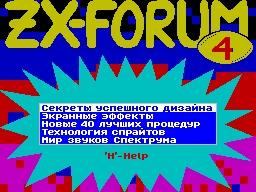|
ZX Forum #04
19 ноября 1997 |
|
world of sound Spectrum - Chapter 1: The Physics of Sound.

World of sound Spectrum
(C) Pavel Lebedev, 1995
Contents
Preface
1. Physics of Sound
2. Operator BEEP
2.1. Creating effects on BEERe
2.2. Making Music on BEERe
3. How is the sound
4. Programming audio codes
4.1. Programming Sound Effects
4.1.1. Tone
4.1.2. Noise
4.1.3. Complexes effects
4.2. Volume Control
4.3. Timbre control
4.4. Programming Music
4.5. Polyphonic ringtones
4.6. Processing of external signals
4.7. Reverberation
4.8. Speech synthesis
4.9. Sound interrupt
5. Operator PLAY
5.1. Creating effects on PLAYe
5.2. Making Music on PLAYe
6. Managing music coprocessor
6.1. Registers
6.2. Programming
7. Software Review
7.1. Sound effects editor Super
Sound
7.1.1. Effects
7.1.2. Using Effects
7.1.3. Version
7.2. Music editor Wham The Music
Box
7.2.1. Load Tune
7.2.2. Save Tune
7.2.3. Edit Mode
7.2.4. Help Page
7.2.5. Hear Tune
7.2.6. Set Tempo
7.2.7. Whampiler
7.2.8. Tips
Appendix 1. Listings sound effects
Super Sound'a
Appendix 2. Tips
assembler
Preface
This book is for readers
who decided to write a program and want to
arrange them on a high level, which is impossible without the
use of sonic possibilities ZX-Spectrum. It is composed of the
principle of simple - to complex, and understand it can not
even really trained person. The book also could serve as a
guide for beginners to program in assembly language: it is
literally crammed with examples.
It contains virtually all the information you might need
someday to create a sound as gaming and system software.
The book covers programming only standard audio devices
Spectrum (port # FE and musical co-processor). Such exotica as
DAC, ADC, MIDI, inherent in the Spectrum - monsters (ATM
TURBO, PROFI) and some homemade products, even not affected
because of its non-standard. Although using only one DAC (DAC)
can be would create an almost fantastic
sounds. Perhaps someday in the future I
will describe these tools and create sound.
Now that the same is still contained. The first chapter deals
nature of sound and its characteristics. In
following three chapters describe the operator Spectrum-BASIC
BEEP, the creation of its using effects and tunes.
The next chapter tells how
as in the ZX-Spectrum obtained by sound as well as on port 254
(# FE).
Further tells of the creation of effects
and music, native.
Then - on the processing of signals from the tape input on
your computer and the programs that synthesize human speech.
The next chapter describes the sound of the interrupt.
The second part of the book is devoted to music coprocessor
AY-3-8910 (AY-3-8912).
First described by the operator beysika128 PLAY and
everything connected with it.
The next chapter will help you understand
in the management of co-processor and its registers. With its
help you learn how to program the chip in the AY code.
And finally - an overview of the software, which includes a
variety of music editors, editors, sound effects, speech
synthesizers, demonstration programs, etc. Described in detail
three such programs. This SUPER SOUND - Editor sound effects,
WHAM THE MUSIC BOX - music editor and ASC SOUND MASTER
(ASM) - music editor for the coprocessor.
In Appendix 1 there are listings of all
sound effects of the program SUPER SOUND, a
Annex 2 gives tips assembler GENS4.
Symbols used in this book
CS - Key Caps Shift;
SS - Key Symbol Shift;
CS / 1 - rollover
(In this case, the Caps Shift and 1);
A +2 - a sequence of keystrokes
(In this case A and 2);
[1] - the number of publications in the bibliography,
at the end of the book.
1. Physics of Sound
Scientifically speaking, the sound - a mechanical
longitudinal vibrations of an elastic medium. Speaking the same
language of ordinary mortals - it is only a vibration of air.
The human ear is very sensitive to
changes in air pressure, it picks up the slightest fluctuations
in it.
A person can perceive sound vibrations with a frequency of
20 to 20,000 Hz (Hz - hertz. One oscillation per second). Sound
with frequency of less than 20 Hz is called infrasound and more
20000 Hz - ultrasound.
The greater the frequency, the higher
audible sound. The sensitivity of the ear is not
the same across the entire range of sound frequencies. The
lowest and highest frequencies seen much worse than average.
Volume of the sound depends on the amplitude and is measured
in decibels (dB). The greater the amplitude, the louder audible
sound. A person can perceive sound with the volume from 0 to
130 dB. The loudest sounds (100 - 130 dB) are perceived
painful, and when the volume more 130 dB burst eardrums in
ears, and a person becomes deaf.
The following characteristic sound - timbre.
Timbre - a form of sound waves. Because the human ear can
distinguish voices, we can distinguish the sound of guitars
on piano. For clarity, take a look
Figure 1. There are two sound waves
with different timbres.
Another feature - the frequency. If a sound wave consists of
a repeating fragment, such sound can be considered periodic,
but otherwise - no. Periodic sound is perceived as a musical
tone, and the non-periodicity - as noise. There are several
different types of noise. The two most common - white noise and
impulse noise. Their diagrams are shown in Figure 2.
The latter characteristic sound - duration. It is creating
an artificial, since it determines not the sound, and the time
it sound. Basically this feature
used in music.
All of the above options sound
rather relative, because every
a person perceives them differently. For example,
the same sound can be a single person
seem too loud, and another - too quiet.
Other articles:
Similar articles:
В этот день... 30 December